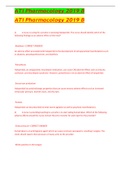Exam (elaborations)
ATI Pharmacology 2019 B
- Course
- Institution
ATI Pharmacology 2019 B ATI Pharmacology 2019 B 1) A nurse is caring for a pt who is receiving Haloperidol. The nurse should identify which of the following findings as an adverse effect of the med? -Akathisia = CORRECT ANSWER An adverse effect associated with haloperidol is the dev...
[Show more]



